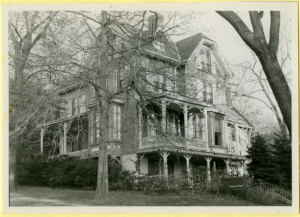By: Jamie Wiggan
According to Bill Bryson, prohibition was “probably the worst social experiment conducted anywhere ever.” But whether or not you’re sold by Bryson’s hyperbole, the consensus that it was an overwhelming failure meets little pushback across the board. American Spirits, an exhibit running at the Senator Heinz History Center through June 10th, offers an interactive and engaging way to explore the social and political complexity that birthed the prohibition—both at the national level and here in Western PA.
In one sense, neatly sweeping aside The Prohibition as an absurdity—an inexplicable moment of madness—is lazy, and a bad way to do history. It’s free-riding on the gift of hindsight. Instead we should be asking: “why did it happen—what does it tell us about American society in the run-up to 1920?” According to senior curator, Leslie Przybylek, unpacking these questions is the main objective of American Spirits.
“[Prohibition] really had to do with a set of circumstances in one moment in time that provided the right climate so that politically, prohibition is an argument won out. And that’s really what the exhibit looks at.”
So what are some of the finer ingredients that went into this perfect storm of politics, social attitudes, and chance? Przybylek suggests we have to go back another 100 years to trace them.
“[Going Back] you had a very religious streak with, for example, Methodists, Presbyterians—who always were on the side of temperance. You had wave after wave of immigrants coming to this country . . . they were in many cities (and Pittsburgh’s one of them); they were the groups that controlled the liquor industries.” “One of the untold stories of prohibition is, there’s a real piece of it that is about the reaction to immigrants and different ethnic groups . . . and that clash of, whose country is this? Whose laws shall we follow?”
One feature of the exhibit that really underscores the significance of ethnic identity in the outworking of prohibition is an interactive quiz that helps you determine what your position may have been, had you lived during 1920-1933. Answering in the affirmative to “were you born outside the US?” and to other statements that suggest you come from emigrant stock, “Are you Catholic, Orthodox, Jewish, or Episcopalian?” “Do you live in a city?” all score you points in the opponents’ camp.
In addition to Protestant groups and those laying claim to a ‘pure’ American identity, women, as a social unit, stood as a potent force in the temperance movement. Since alcoholism—that for much of early American history posed a serious social concern—primarily affected men, it was consequently women who bore the brunt of its ill-effects: domestic violence, family instability; and in a society where employment was largely limited to men, poverty. Naturally women began to resist, and temperance became closely aligned with feminism throughout the 19th and early 20th centuries. Amongst the most intriguing objects on display at American Spirits is one of the famed axes by which the legendary temperance campaigner, Carrie Nation, obliterated liquor supplies and uprooted saloons. It is recorded that she was imprisoned over 30 times for these protests.
The era of prohibition—the Roaring 20s—is notable as a time of rapid social change, despite prohibition’s conservative agenda. Przybylek even argues that the legislation helped spur evolving social norms. “[It] creates these new organizations called Black and Tan Clubs, places where men and women are purposefully getting together to socially drink, to dance, to listen to music.” Before prohibition, it was rare for men and women to drink together in a social setting.
Ironically, many of the feminists who had fought hard to promote temperance came to resent the new forms of feminine expression that emerged. “So they get the right to vote . . . and then they turn around and watch the flapper generation . . . this was a younger generation that looked at what happened in Europe [during WWI] and looked at the experiences of the men that came back here, and this was their version of saying, you know what—we’re tossing the old way” explained Przybylek. “Some of the historic leaders of the suffrage movement looked at those young women—these flappers—and just shook their head and thought, really?”
Despite the many societal threads that fed into the enactment of Prohibition, none of these as individual factors could have brought about the legislation outside the political and social climate that have formed. In fact, Przybylek wagers “ if you put prohibition to a popular vote in this country, I don’t think it ever would have passed . . . Cities never favoured it. The State of Maryland never even passed it.” American Spirits uncovers this paradox through a careful display of the propaganda and political tools that made the legislation possible amid a volatile period of American identity. “Prohibition was a political victory,” says Przybylek.
Beginning with the Whiskey rebellion of the 1790s, and concluding with a nod to the many craft breweries and local distilleries now dotting the Pittsburgh metropolis, American Spirits contextualizes prohibition as a single chapter in a lengthy narrative of drink—locally and nationally. This is a narrative that rarely recoils from contention. But an optimist, whether sipping a Witbier in the East End or savouring a small-batch bourbon along Smallman Street, might claim the return to local brewing and distillation methods marks a healthy trend towards appreciating alcohol for its taste, not just its effects. But I shouldn’t get ahead of myself, I am writing for a college campus.
Whether or not you identify as a history buff, American Spirits offers the guarantee of an afternoon well spent. Head down to get a free mug shot alongside the infamous Al Capone and his mafia cronies; see how those cardboard cases of Budweiser that line your baseball-loving-uncle’s fridge have evolved from cumbersome wooden baskets; or test your skills at keeping rum-runners out of port—all for a student rate of just $6.50.
More info on the American Spirits exhibit can be found at:
http://www.heinzhistorycenter.org/events.
Stay tuned for further programs on this topic.
American Spirits
April 3, 2018






